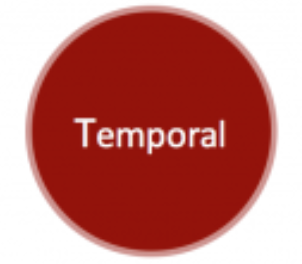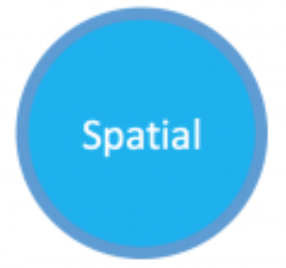Additional Topic Lens Resources
Temporal
Timelines can help audiences visualize how events occurred in sequence, in relation to one another, and in context with other events.
- TimeLine Tips and Tricks
- Arc Diagram Timeline—Arcs can be used to show connections between events (which appear as nodes along the timeline).
Spatial
Traditional maps (contemporary and historical) and narrative-driven StoryMaps help audiences understand how events, locations, or other content relate to one another geographically.
- Create a StoryMap (Via SLU's Digital Narratives platform or Knight Lab)
- Finding Maps Resource Guide
- GoogleMaps
- Perry-Castañeda Library Map Collection—The University of Texas's extensive collection of modern and historical maps.
- David Rumsey Map Collection—More than 10,000 maps with a focus on rare 18th and 19th century North and South America maps and other cartographic materials.
- ARTstor (includes maps, via SLU databases)
- SLU campus maps from 1920s-today
Textual
Most presentations rely on text in some form. Which text-based sources will best help you to achieve your goals for your project? Consider both primary sources—letters, diary entries, etc.—and secondary sources—books, journal articles, online articles, etc.
Word clouds, treemap charts, and other text-based data visualizations can help audiences understand hierarchies, including the most prominent words and themes in a text.
Historical newspaper databases:
- African American Newspapers (Via SLU Databases)—Indexes newspapers owned and operated by African Americans from more than 35 US States.
- African Newspapers (Via SLU Databases)—Indexes over 60 African newspapers published in the 19th and early 20th centuries.
- Alt-PressWatch (Via SLU Databases)—Indexes the publications of the alternative and independent press in America. Includes significant full text coverage of newspapers, magazines and journals.
- New York State Historic Newspapers (Via SLU Databases)—Digital archive of newspapers from around New York State.
- Newspaper Source (Via SLU Databases)—Selected full text coverage of 240+ newspapers and other news sources.
- NexisUni (Via SLU Databases)—Formerly LexisNexis Academic. More than 17,000 national and international news, business, and legal sources.
- Nineteenth Century Collections Online (Via SLU Databases)—Nineteenth century primary source collections.
- Chronicling America: Historic American Newspapers (via Library of Congress)
- Historic Newspapers on Flickr (Part of the LC Flickr Commons photostream)
- Newspapers.com—18,400+ newspapers from the 1700s–2000s
- Google News Archive / “How to Search the Google News Archive” (ThoughtCo)
- Elephind.com
Note that some historical newspaper databases (outside SLU) may have a paywall. But most archives will allow you to search for free—obtaining the name and date of your desired publication can help you locate the record from another free service.)
TIP: Images of newspaper clippings can also add visual interest to your narrative.
Visual
Which images, illustrations, videos, 3D models, etc. would help your audience to visualize your subject(s)?
Image databases:
- Academic Images—an extensive list of digital image resources.
- AP Images—Over six million images from the Associated Press, one of the largest and oldest news organizations in the world. Images date back to the mid-nineteenth century and more than 3,500 new photographs are added daily.
- ARTstor (via SLU Databases)—A worldwide index of digital images. Includes photographs, maps, posters, architectural plans, sculptures, paintings, and illuminations.
- New York Public Library Digital Collections—Explore 897,000+ items digitized from the library’s collections. Features prints, photographs, maps, manuscripts, streaming video, and more.
Statistical
Statistics can help you locate the story or stories within your data and research. Presenting the right statistics in a compelling way can help you convey those stories to your audience.
What data or datasets are you working with? How can you best help viewers to visualize or contextualize the information?
- How to Make an Infographic in Five Steps / The Ultimate Infographic Design Guide (Venngage)
- Overview of Graph Types (Data to Viz)—a handy guide to 30+ types of graphs you can use to present your data.
- Making Data Meaningful Part 1: A Guide to Telling Stories with Numbers (UNECE)
- Making Data Meaningful Part 2: A Guide to Presenting Statistics (UNECE)
Oral
Which audio recordings could help enrich your viewer’s sensory experience of your topic and further connect them to a place and time? Consider drawing on existing audio archives or capturing your own field recordings or oral history interviews.
Existing audio archives:
- NPR—links to a range of sources offering archival audio clips
- Library of Congress—links to major archives of recorded sound from throughout the world.
- Internet Archive—with 4.5 million audio recordings (including 180,000 live concerts)
- Oral History Archives at Columbia University—one of the largest oral history collections in the United States with more than 10,000 interviews.
- UCSB Cylinder Audio Archive (UC Santa Barbara)
Tips for capturing your own oral history interviews:
- Planning an Oral History Project and Interview Tips (American Folklore Center / Library of Congress)
- Conducting Oral History Interviews with Family Members (UCLA Library)
- Oral History in the Digital Age (Institute of Museum and Library Services)—includes more than sixty micro-essays on Best Practices for collecting, curating, and disseminating oral history projects
- Archiving Oral History: Manual of Best Practices (Oral History Association)
Archival
Which archival materials—photos, motion pictures, home recordings, sound recordings, etc.—can help viewers relate to the events or time periods you are covering?
- SLU Digital Collections
- SLU Special Collections
- Saints Sports Articles Archives -- News stories archives for the St. Lawrence University Saints.
- New York Heritage – From the site’s “About” page: “The collections in New York Heritage represent a broad range of historical, scholarly, and cultural materials held in libraries, museums, and archives throughout the state. Collection items include photographs, letters, diaries, directories, maps, books, and more.”

